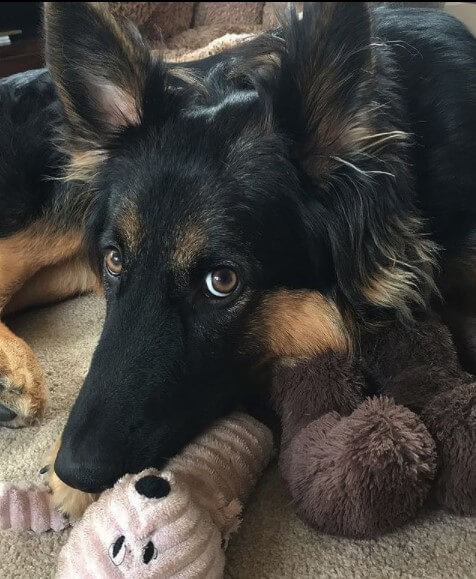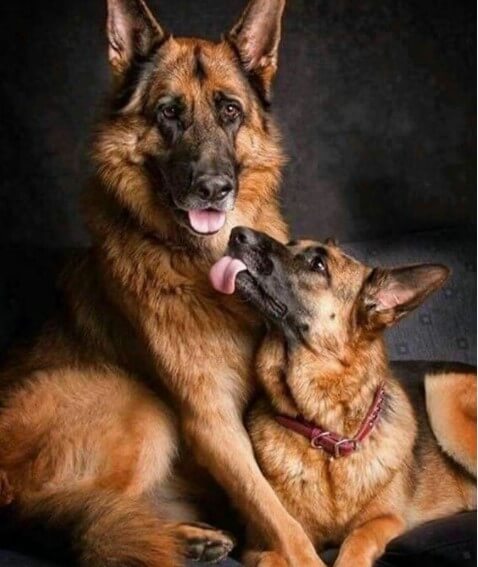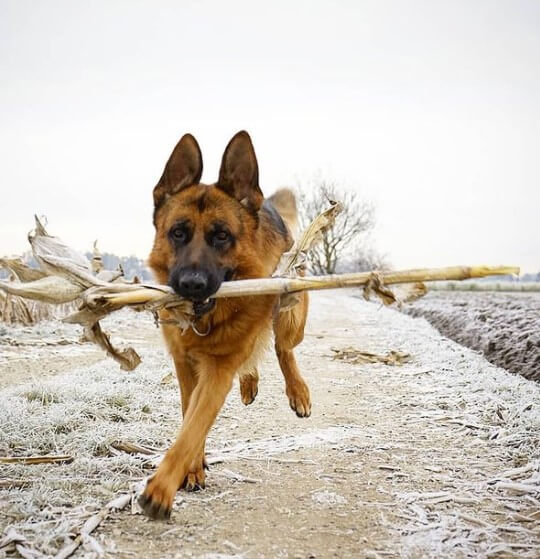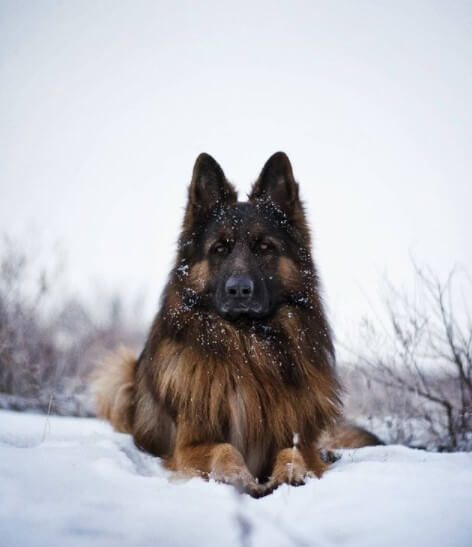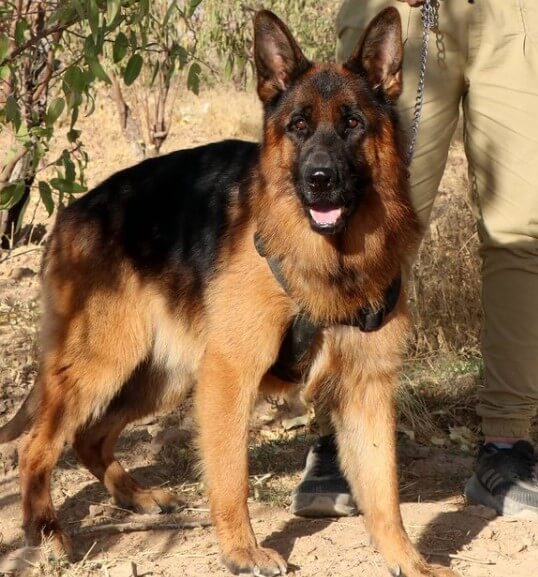The German Shepherd is a regular at the top of the ratings of the smartest, most loyal, most trainable pets. The noble “faces” of these dogs often appear in news stories, on newspaper strips, and even in the title roles of various TV shows. But the main vocation of the Germans is not an acting career, but the maintenance of order. They serve in the police, border, and customs units, and assist in search and rescue operations. At home, representatives of this breed protect the peace and property of the owners, give their owners a lot of positive emotions.
Brief Information
- Breed name: German Shepherd
- Country of origin: Germany
- Time of origin of the breed: late 19th century
- Weight: males 30-40 kg, females 22-32 kg
- Height (height at the withers): males 60-65 cm, females 55-60 cm
- Life span: 10-13 years
Key Facts
- German Shepherds can be used as guard dogs or search dogs as well as companions for families.
- Devoted and complaisant pets unquestioningly recognize the authority of the owner.
- German Shepherds are among the top three smartest dog breeds (along with Border Collies and Poodles).
- They need human society and physical activity.
- Get along well with children of all ages.
- They are able to live not only indoors, but also in an aviary.
- The average life span of a German Shepherd is 9-13 years, after 7 years, strict health monitoring is required.
History of the Breed German Shepherd
To trace the history of some breeds, it is enough to turn to official documents and eyewitness accounts. The situation with German Shepherds is quite different. According to the researchers, the beginning of the chain of their immediate ancestors should be sought in the depths of centuries.
Archaeological finds indicate that even in the 4th millennium BC, animals lived on the territory of the modern Czech Republic, Poland, and Germany, the skeleton of which has many features similar to German Shepherd Dogs. These were the consequences of the evolution of wild individuals who chose life near the sites of ancient tribes and became dependent on humans. It is assumed that even then some primitive selection was carried out, during which the largest and most obedient puppies were selected.
The now-non-existent small Indian wolf moved further and further from its “free” relatives and gradually turned into the so-called dogs of the Bronze Age. The needs of people have changed over time. Not only farmers but also pastoralists were in one way or another tied to a certain area. This means that the four-legged companions have new functions. In the Middle Ages, Hovawart was bred throughout Europe. This German word is translated as “guardian of the yard”, but dogs were engaged not only in the protection of the real estate.
Domesticated livestock needed reliable protection from ruthless predators and hunters for other people’s property. Given the growing number of herds and flocks, it was simply impossible to cope with such a task with the help of shepherds. It was then that the yard dogs came to the rescue. Of course, not everyone was suitable for such work, but only the most quick-witted and hardy. They began to be selected and trained in a special way. And everything special is valuable, therefore, already in the 7th century, according to the laws of the ancient Germanic tribe of Alemans, a severe punishment awaited the culprit for killing a shepherd’s dog.
Of course, the animals of the early Middle Ages, and even much later eras, outwardly resembled little modern representatives of the breed. Fundamentally important for the so-called primitive German Shepherd Dogs were considered not the shape of the head and the setting of the tail, but the corresponding intellect, rather large dimensions, and “psychological portrait”. The fact is that the way of life of the shepherds presupposed prolonged isolation, during the grazing season, the animals actually contacted exclusively with “their” person and had to not only obey him without question but also become good companions to him.
By the 18th century, the situation had changed somewhat. Two regional types of German Shepherd Dogs took shape at once – the semi-long-haired Thuringian pale-gray color with a curling tail and the long-haired Württemberg black or red color with semi-erect ears. They also differed in character: the former was called active animals, prone to loud and frequent barking, and the latter could boast of calmness and endurance. In the name of a common cause, breeders from the central and southwestern lands decided to join forces.
The result of the painstaking work of enthusiasts was presented to the general public only at the end of the 19th century. Baron von Knigge brought two of his pets to the Hanover Dog Show in 1882, the males Greif and the Cuirass. Later, the owners of the Hannau kennel fueled interest in the new breed, who showed the public an impressive pair – large and strong-built Pollux and Prima. It was thanks to them that almost two dozen champions and winners of exhibitions of subsequent decades were born.
In 1891, the first German Shepherd Society was announced. The organization “Phylax” did not last long but managed to approve the breed standard. The next significant event is the exhibition in the small town of Karlsruhe on the German-French border. The event would have remained unnoticed if it had not been for an outstanding representative of the old format type. And not among the participants!
Hector von Lierckenhain merely entertained visitors with a demonstration of herding skills. By a happy coincidence, a retired military man Max von Stephanitz and his friend Arthur Meyer passed by, who devoted their free time to breeding German Shepherds and immediately noticed the perfect appearance of the dog, which was in no way inferior to its working qualities. The owner, however, did not want to part with his pet just like that, it took several weeks to negotiate.
Having received the ideal “German”, von Stephanitz entered his first number into the studbook under a new name – Horand von Grafrath. The efforts were rewarded, in the litters received from Horand, a sufficient number of worthy heirs of the breed were born.
Back in April 1899, the German Shepherd Owners’ Union was created. The activities of von Stephanitz, Meyer, and other leaders were aimed mainly at maintaining the purity of the blood, which would be confirmed by the relevant documents, encouraging outstanding breeders and developing the working qualities of the breed. The organization still exists, and in May 1968 an international association was founded, which is today known as the World Union of German Shepherd Associations, and brings together 89 national unions from 82 countries.
Dimensions and Weight. Appearance
The weight of an adult male should vary from 30 to 40 kg and the height at the withers from 60 to 65 cm. The female weighs less – from 22 to 32 kg, and reaches 60 cm at the withers.
The color varies greatly: from weakened to darkened zonal – black and tan.
The coat can be of three types: short hard, long hard, and long soft.
Long-haired German Shepherd, paradoxical as it may sound, is much less cold-resistant than short-haired, these dogs are not recommended to be kept in cold enclosures.
German Shepherd Personality
Without exception, all owners of German Shepherds call them faithful, intelligent, calm, and obedient animals. A stable animal psyche and a correct upbringing are the keys to a wonderful character.
The high intellect of the Germans is not accompanied by the desire for independence and stubbornness, they easily and with pleasure master new games, teams, territories. Dogs do not like loneliness, but they patiently wait for the owner’s return. For a good mood and normal health, they are in dire need of human society, including long walks and outdoor games.
One of the important features of the German Shepherd Dog is innate protective instincts, therefore, they are wary of strangers in the house and even during a walk, although they never show aggression without a reason. Devotion to the owner and family of these pets is raised to the degree of the absolute, they are ready to sacrifice themselves, protecting the household from danger, and they assess the degree of danger instantly and adequately.
German Shepherds love children and play with them with pleasure. However, it is not recommended to leave babies alone with a dog – if only because of the difference in size and weight. The Shepherd is tolerant of other animals in the house, friendly relations are possible if they grow up together.
Training
As mentioned above, German Shepherds are intelligent and easily trained animals. But raising a large dog should never be left to chance. From the first months of life, in the form of interesting games and tasks, the fulfillment of which is accompanied by obtaining a treat, the puppy gets an idea of the permissible norms of behavior and important commands.
The owner should demonstrate his authority without resorting to shouting and, moreover, physical strength. If it seems to you that there are significant deviations in the behavior of the puppy that you cannot cope with yourself, be sure to seek help from a specialist dog handler.
Of course, not every German Shepherd becomes a service dog and protects order in special units. But even a pet needs to understand and respond appropriately to basic commands.
When the puppy’s bones are strong enough, you can start overcoming obstacles (be sure to take into account the correspondence of the height to the growth and capabilities of the pet). The fundamental point is teaching the dog to walk on a leash, and from six months – in a muzzle. It is better to do this gradually and do not forget about the tasty reward for obedience.
It is important to remember that German Shepherds reach psychological maturity quite late, by the age of three. A young dog, in size quite corresponding to the breed standard, internally remains vulnerable, requiring care and approval from a puppy.
Conditions of Detention and Care
Features of the structure of wool allow the German Shepherd to live both indoors and in the yard. In the second case, you need a spacious aviary with an insulated booth. In addition, it is advisable to at least partially protect the aviary from precipitation and wind.
Immediately after the dog appears in the house, determine for it its own place, where the bedding or mattress, toys will lie. There should be no direct sources of heat or drafts in the immediate vicinity. Natural materials are preferred for the bed, which do not require complex cleaning. A sufficient number of toys will protect furniture and shoes from sharp teeth.
As it gets dirty (but not too often), bathe your dog in warm water with special shampoos. Combing is carried out once or twice a week, during the period of seasonal molting, the procedure has to be performed more often. The condition of the ears, eyes, mouth, and nasal passages should be monitored regularly.
It is recommended to visit your veterinarian for a routine check-up at least 2-3 times a year.
Feeding
The main aspect of proper maintenance of any dog is a balanced diet that will ensure normal development and good health for life. The easiest way to guarantee a complete diet can be premium and super-premium ready-made feeds for the respective age category, and for adult animals – taking into account special needs. With a “natural” diet, it is important to follow the veterinarian’s recommended protein to fiber ratio. And, of course, you cannot feed the German Shepherd with scraps from the human table, because its digestive system is not ready to work with fatty, fried, salty foods and spices. Freshwater must be available at all times.
Health
The average life span of a German shepherd is 9-13 years.
Difficulties in the formation of the breed and forced inbreeding led to the emergence of a number of serious diseases. Some are manifested even in puppyhood: growth hormone deficiency, diabetes, leukemia, eosinophilic panosteitis (intermittent claudication), intussusception of the intestine, pyoderma (purulent skin lesions). Later, allergies, hip dysplasia, diseases of the intervertebral discs, arthritis, corneal dystrophy of the eye, epilepsy, cataracts, pancreatic insufficiency, dysplasia of the tricuspid or mitral heart valve, aortic stenosis (narrowing of the vascular opening) (exudative pericarditis) (exudative pericarditis) cancer, hind limb paralysis.
Under the influence of external factors, ear and eye infections, dermatitis, volvulus, bloating and others can begin.
At the first sign of poor health, you need to go to the veterinary clinic, where they can make the correct diagnosis and start treatment. It is also important to see a doctor regularly for routine check-ups – especially for puppies in active growth and dogs over 7 years old.
How to Choose a Puppy
The above-mentioned features of appearance and character refer to purebred German Shepherds, that is, to those whose pedigree has been confirmed by official documents for several generations. Half-breeds can certainly be wonderful and loyal pets, but they are still completely different dogs.
Future owners who are interested in a particular breed should look for a puppy only from trusted breeders and in kennels with an excellent reputation. So you can be sure of the absence of genetic diseases and the “trademark” stability of the psyche, which is so important for a large pet.
Responsible breeders do not give out puppies to buyers that are less than 8-10 weeks old. By this time, the little German is already confidently on his feet, responds to his own name, and is ready to start training.
If a dog is purchased not for breeding and participation in exhibitions, the main selection criteria are its health and friendliness. Indicators of the first are considered to be good appetite, playfulness, clean eyes, nose and ears, shiny coat, elastic stomach without signs of bloating. The Young German Shepherd should not be afraid of calmly behaving people or reacting aggressively to attempts to approach.
It is also better to “get acquainted” with the parents in order to have an idea of the heredity of the future pet and to look at the conditions of keeping mothers with babies. Cleanliness, ample space, quality food and toys, and timely vaccinations are undeniable evidence in favor of the breeder.


